|
The Boncuk, and there is more
you should know about Turkey
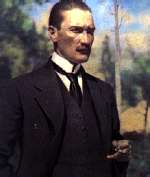 Atatürk, a very short but important note: Atatürk, a very short but important note:
The history of modern Turkey starts with Mustafa Kemal Atatürk, President of the Turkish Republic from 1923
until his death in 1938.
Dramatic steps were taken by Atatürk, Father of the Turks, this title was officially given to him during his
presidency.
In his program of modernization, secular government and education played a major role. Making religious faith a
matter of individual conscience, he created a truly secular system in Turkey, where the vast Moslem majority and
the small Christian and Jewish minorities are free to practice their faith. As a result of Atatürk's reforms,
Turkey -unlike scores of other countries- has fully secular institutions.
These are his main reforms
*the Latin alphabet
*the introduction of the surname
*voting rights for women
and it was he, who made the 23. of April World *Children's Day
Atatürk still nowadays is highly admired. That's why you see his picture everywhere
Balik Express
Nazar Boncuk,
that is the Little Magic Stone that protects one from the *Evil Eye*
This is a typical item, a specialty of this region you should take home as a souvenir, it's called the Boncuk,
the Little Magic Stone that protects one from the *Evil Eye* (pronounced 'bon-dschuk'), you will see this blue
glass piece everywhere here on the Aegean Coast.
But what is behind this superstition? In a shortened version we will try to explain.
Once upon a time (yes, it starts like in a fairy tale) there was a rock by the sea which, even with the force of
a hundred men and a lot of dynamite, couldn't be moved or cracked. And there was also a man in this town by the
sea, who was known to carry the evil eye (Nazar). After much effort and endeavor, the town people brought the man
to the rock, and the man, upon looking at the rock said, "My! What a big rock this is." The instant he
said this, there was a rip and roar and crack and instantly the immense and impossible rock was found to be cracked
in two.
The force of the evil eye (or Nazar) is a widely accepted and feared random element in Turkish daily life. The
word *Nazar* denotes seeing or looking and is often used in literally translated phrases such as "Nazar touched
her", in reference to a young woman, for example, who mysteriously goes blind.
Another typical scenario. A woman gives birth to a healthy child with pink cheeks, all the neighbors come and see
the baby. They shower the baby with compliments, commentating especially on how healthy and chubby the baby is.
After getting so much attention weeks later the baby is found dead in his crib. No explanation can be found for
the death. It is ascribed to Nazar. Compliments made to a specific body part can result in Nazar.
That's why nearly every Turkish mother fixes with a safety pin a small Boncuk on the child's clothes. Once a Boncuk
is found cracked, it means it has done his job and immediately a new one has to replace it.
Sandal Thai & Chinese
A restaurant that does justice to Oriental cuisine is SANDAL which serves excellent Thai and Chinese
dishes at very reasonable prices. To eat there is a rare pleasure and the only problem you may face is deciding
on a choice from their extensive menu. All the dishes that we tasted were
excellent. SANDAL is on Atatürk Street, a short walk east from the middle of town. - this is one of oldest
quality restaurants in Bodrum. Run by Mustafa and his Thai wife (the genius behind the superb dishes) since more
then 12 years. The authentic decoration makes you feel in one of these restaurants on the coast in Thailand. Tel
316 9117
Ibo
Located in the heart of the hustle and bustle of central Bodrum Ibo is a traditional Turkish restaurant
set in the midst of the vines giving essential shade. Traditional Turkish musicians play their trade in the small
restaurant. There are a variety of foods on offer from simple Turkish dishes to basic western food. Pricing is
medium range.

 if
you have any suggestions or experiences, please drop
us a note if
you have any suggestions or experiences, please drop
us a note
|

|
|

|
|
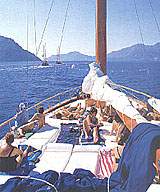
|
|
Bodrum is the ideal starting point for the famous
 Blue Cruise Blue Cruise

|
|

|
|
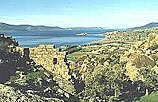
|
|
 In ancient times - open sea, today a lake, the Bafa Gölü In ancient times - open sea, today a lake, the Bafa Gölü

|
|
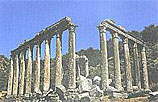
|
|
 not far from Bafa lake, Euromos, another hidden gem not far from Bafa lake, Euromos, another hidden gem
|
|

|
|
|
Free Downloads

|
|
|

|
|

Send a Bodrum Postcard
|
|

|
|

|
|

|
|
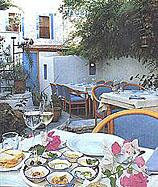
|
|

Epsilon - in a romantic garden.

|
|
|
|

|
|
 the castle of St. Peter is a landmark
from all points of view the castle of St. Peter is a landmark
from all points of view
|
|

|
|

|
|